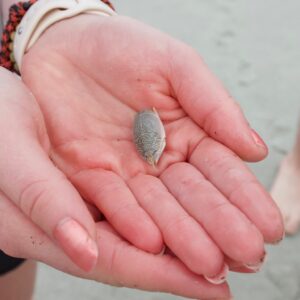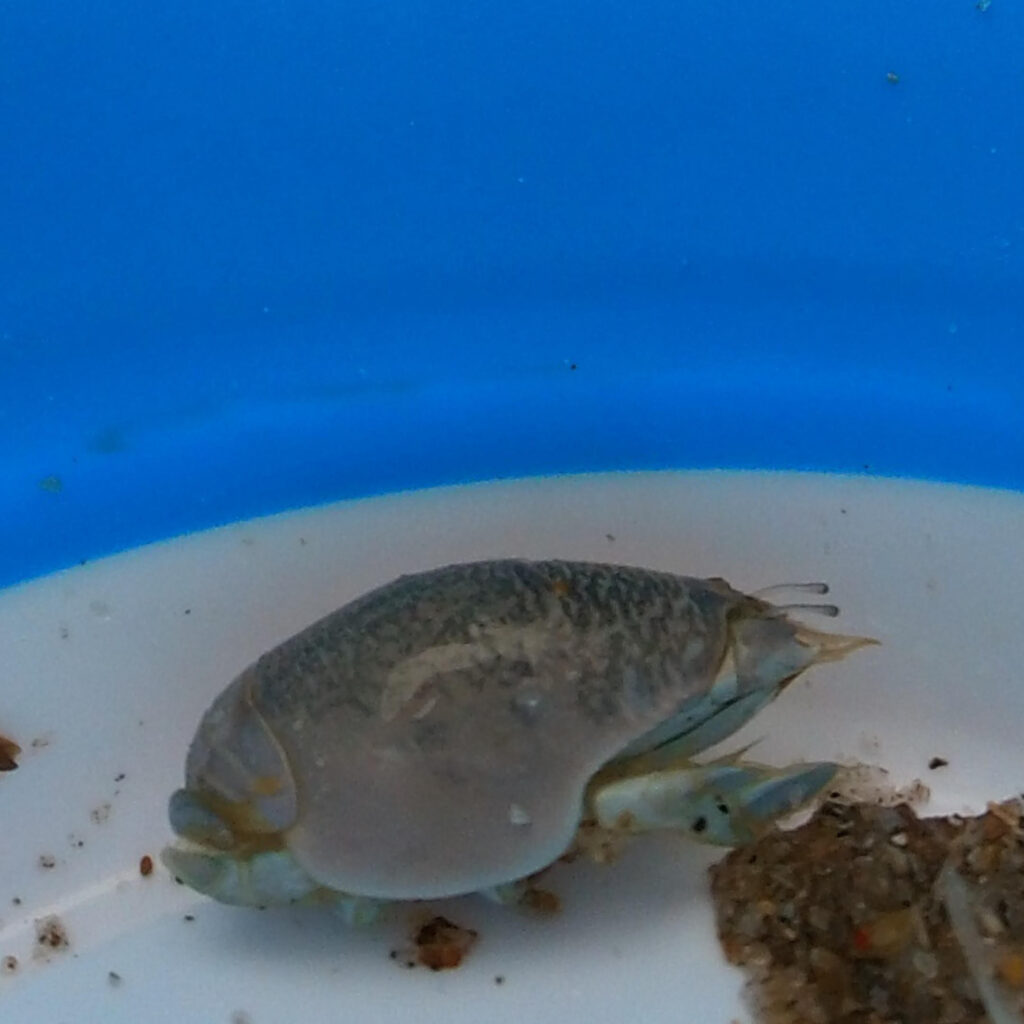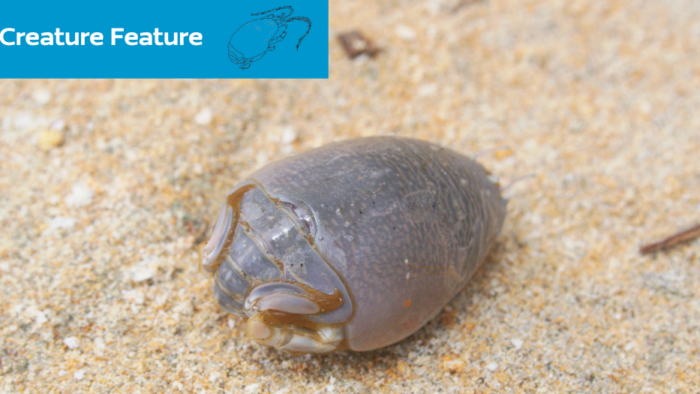By: Hannah Gillespie
Atlantic Mole Crabs are harmless creatures that live in colonies where the waves wash over the beaches, known as the swash zone. They are uniquely adapted to live in this relentless environment of constant movement and changing tides.

These tiny crustaceans are typically less than an inch long, with females usually growing larger than males. They wear a domed, oval shell that ranges from a speckled light gray to tan in color.
This armor acts as both a sand-like camouflage and protection from oncoming waves. Underneath their egg-shaped exoskeleton, mole crabs have five pairs of short, white leg-like appendages and a small tail, called a telson, which assists with digging, burrowing, and bracing for impact.
Unlike other crabs, mole crabs keep their claws tucked beneath their shells, and they have the unusual ability to tread water if they become dislodged from the sand. Also unique to mole crabs is how they burrow backward into the sand, exposing just their stalk-like eyes and featherlike antennae. From this position, they use their antennae to quickly filter for plankton, algae, and other tiny organisms as the tides roll in, a process known as filter feeding.
Mole crabs have a relatively short life span of about two to three years. They become sexually mature at one year, with mating typically occurring between February and October, depending on the region. During this process, a male will become semi-parasitic by attaching himself to a larger female. A female may produce as many as 45,000 orange-colored eggs per month, which she carries on her abdomen until they hatch. For the next two to four months, the larvae drift with the current, which may carry them long distances.
Threats
Mole crabs are vital prey for shorebirds and fish, which makes them a popular bait for shoreline fishermen.

Although they have not yet been assessed for their global conservation status, our Florida Conservation Project team has reason to believe that mole crab populations locally might be declining in specific areas on or near Canaveral National Seashore. Led by Dr. Robert Sluka our team has studied the spatial and temporal distribution of these tiny creatures and conducted interviews with locals that support that conclusion.
In interviews, local fishermen have suggested certain human activities that may contribute to the decline of mole crab populations, including dredging and beach renourishment. These practices involve pouring fresh sand on the beach to protect the area from storms and erosion and support tourism. This changes the characteristics of the beach in ways that may impact mole crab populations. The team continues to investigate possible explanations for perceived declines and will continue the study until Fall 2025.
This mystery pushes us to consider additional human activities beyond our research that could be detrimental to sea life. Notably, mole crabs are susceptible to the threat of ocean acidification, a chemical change in the water that is triggered by an increased amount of carbon dioxide being absorbed by the ocean. Many human-caused factors contribute to ocean acidification, including the burning of fossil fuels and deforestation.

Research shows that while some sandy beaches are relatively unaffected by tourists and human activity, beaches in urban areas or areas with many tourists tend to be the most deteriorated because of long-term pollution or other factors that disrupt the sand, such as the use of off-road vehicles. Time and time again, the data shows that human activity may be negatively impacting the mole crab population. In 2017, Dr Sluka and colleagues published interesting work based out of A Rocha’s field study center in Kenya which indicated that some species of crab can be indicators of human impacts – perhaps mole crabs are too.
For more information on A Rocha’s study of mole crabs in Florida, check out this Interactive Storymap: Sand and Spirit. Have a question? Ask it in the Marine Conservation group in Love Your Place, A Rocha USA’s dynamic, online community.
You can support our Mole crab research and other marine conservation efforts by donating to A Rocha USA (Designate your gift to “Specific Project, Florida Conservation Project”).

Atlantic Mole Crab
(Emerita talpoida)
Range: The Atlantic Coast (from Cape Cod to Florida) and the Gulf of Mexico
Habitat: Where waves crash over the sand on beaches, known as the swash zone
Physical Characteristics: Tiny, egg-shaped, and speckled gray/tan in color
Reproductive Season: February through October, but varies by region
Lifespan: Short, 2-3 years
Fun Fact: A female mole crab can produce as many as 45,000 eggs per month
Conservation Status: Currently not assessed









Add a Comment